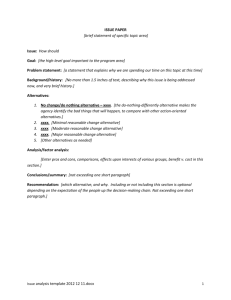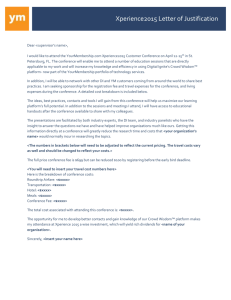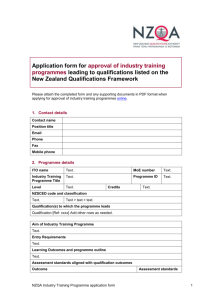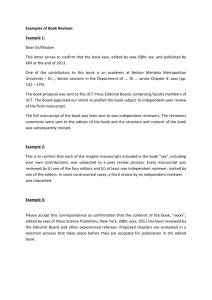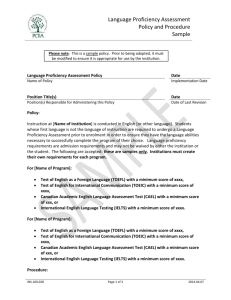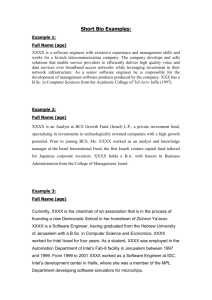Administrative Business Continuity Plan Template
advertisement
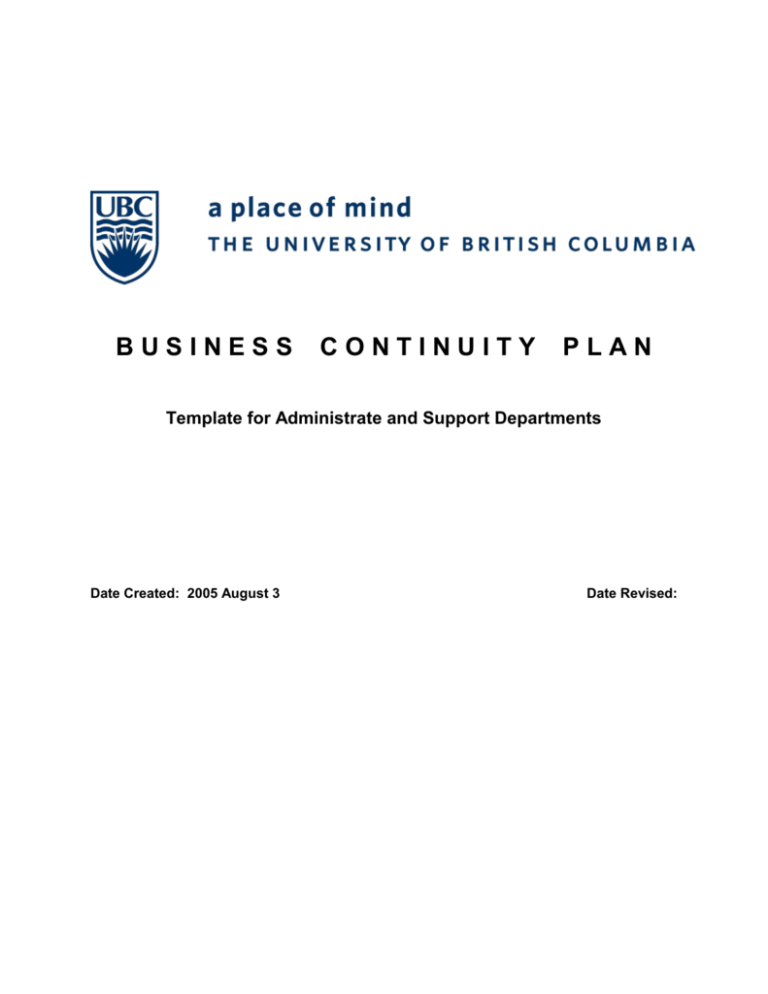
BUSINESS CONTINUITY PLAN Template for Administrate and Support Departments Date Created: 2005 August 3 Date Revised: Revisions Record Date Section Revised Revision Summary Title Signing Authority Name Distribution List Distributed to: Location Including Address BUSINESS CONTINUITY MANAGEMENT: A holistic management process that identifies potential impacts that threaten an organization and provides a framework for building resilience with the capability for an effective response that safeguards the interests of its key stakeholders, reputation, brand and value creating activities. The management of recovery or continuity in the event of a disaster. Also the management of the overall program through training, rehearsals, and reviews, to ensure the plan stays current and up to date. Basic Elements of a Business Continuity Plan 1. Identify services, business processes, applications, and normal support tools (e.g., business records, computers, telephones, etc.) that must be sustained during an interruption. 2. Identify services, processes, or applications that are not critical and may reasonably be suspended during an interruption. Determine how long the department can function without normal support tools. 3. Determine minimal personnel, supplies, data, equipment, etc. that will be essential to support key functions and recovery efforts. 4. Keep updated contact lists with names and telephone numbers of key personnel and their recovery responsibilities. 5. Identify interfaces to other operating departments’ continuity plans. Which departments does yours depend upon to get its work done? Which departments depend on your unit to get their work done? 6. Ensure that all personnel with operational continuity responsibilities are trained and prepared to respond during a disaster. Revisions Record 1 Table Of Contents page Revisions Record .......................................................................................................................... 1 Table Of Contents ......................................................................................................................... 2 Executive Summary ...................................................................................................................... 3 Scope, Goals and Objectives ....................................................................................... 3 Critical Departmental Functions ................................................................................... 3 XXXX Department Business Continuity Team .............................................................. 4 Department Staff Contact List ...................................................................................... 4 Critical Supplies ............................................................................................................ 5 Vital Records ................................................................................................................ 5 Support Organizations and Agreements ...................................................................... 7 Working from Home ..................................................................................................... 7 On Campus Functions .................................................................................................. 8 Analysis of Risks and Impacts .................................................................................................... 9 Risk Analysis ................................................................................................................ 9 Business Impact Assessment....................................................................................... 9 Recovery Plans for XXXX Department...................................................................................... 10 Scenario A: Pandemic Outbreak .............................................................................................. 10 Function 1:Provide Access to Drawings, Maps and Records ................ [EXAMPLE ONLY] 1 0 Function 2:Plans for Relocation and Space……………………[EXAMPLE ONLY] .......... 12 Function 3:Provides Data and Reports…………………………[EXAMPLE ONLY] .......... 12 Scenario B: All Hazards Event……………………………………… ........................................... 13 Function 1:Security/Access of Radioactive Sources…………[EXAMPLE ONLY] ........... 13 Function 2:Inventory/Purchasing Control………………………[EXAMPLE ONLY] ........... 15 Function 3:Personal Exposure Assessments…………………[EXAMPLE ONLY] ........... 15 BCP Administration .................................................................................................................... 16 Appendix I: XXXX Department Staff Contact List ................................................................. 17 Appendix II: UBC Risk Priority Matrix ..................................................................................... 18 Attachment 1: XXXX Department Business Impact Analysis Worksheet ........................... 20 Table of Contents 2 Executive Summary Scope, Goals and Objectives The scope of this Business Continuity Plan (BCP) is for the XXXX Department to establish the capability to respond to major disruptive University events with minimal impact to the University, its faculty and staff employees. The goals of the BCP are to: Build the Point Grey campus resilience and capacity to manage through any major disruptions Promptly and effectively respond to emergencies and disasters affecting the campus Mitigate the impact of loss or injury to people, physical assets and information systems Maintain the integrity and quality of the BCP through regular reviews and updates, simulation exercises, and systems assessments Promote campus-wide awareness about the importance and purpose of business continuity The objectives of this BCP are to effectively manage the resumption of critical functions of the Risk Management Services (RMS) resulting from a major disruptive event to campus clients within established recovery time objectives (RTOs). The RTOs have been established for all critical functions for each most probable type of hazard event. The BCP for the XXXX Department is posted at: SPECIFY THE LOCATIONS WHERE THIS MANUAL WIL BE KEPT Critical Departmental Functions Definition of “critical” – A function is “critical” if it is essential to the conduct of teaching or research. More specifically, a critical function is one that must be re-started during the first 30 days post-disaster, in order to enable teaching or research to re-start. Indirect relationships. Many functions have only an indirect relationship to teaching or research. These functions may still be critical if their cessation would have a significant negative impact on the University’s ability to carry on teaching or research activities (i.e., space to conduct teaching). Set the bar high. Visualize the department working in a large tent with a few computers on extension cords, and question whether you really need to be doing this function! A major disaster will force the University to prioritize; and to plan effectively these choices must be made now. Critical Departmental Functions Critical Functions Responsible Authority Title/Location/Phone Executive Summary 3 Executive Summary Critical Functions Responsible Authority Title/Location/Phone XXXX Department Business Continuity Team and Chain of Command 1. 2. 3. 4. 5. 6. 7. 8. Director Manager office phone + cell + home office phone + cell + home office phone + cell + home office phone + cell + home office phone + cell + home office phone + cell + home office phone + cell + home LAN or IT Coordinator etc. Department Staff Contact List A hard copy and laminated credit card-sized list of all staff office, cell and home phone numbers has been provided to all staff. The departmental Administrative Supervisor/Manager will update this list every six months. A copy of the list in enclosed as Appendix I. Plan Activation Triggers Trigger Action Any event that overwhelms the ability of RMS Initiate the Plan through the authority of the and first responders to effectively control the Director of the XXXX Department situation Executive Summary 4 Executive Summary Key Recovery Situations A complete summary of the key event scenarios and impacts that can be used to develop operational recovery plans, RTO’s, procedures, and arrangements is listed in Attachment 1. Critical Supplies Resources Access Arrangements Where Located Contact Name & Phone Vital Records In many departments, vital records are not consolidated, and are sitting on multiple hard drives/desk drawers. The first priority is to have the XXXX Department define the essential/vital records through a simple group meetings and discussions. Loss of some records may not cripple the department, but it might have great difficulty in recovering. Various estimates say that roughly 50% of businesses that suffer catastrophic data/records loss never reopen. In UBC’s case, this could mean a significant reduction in enrolment and revenues, delayed restoration of physical assets, and prolonged research efforts. Any records/data that are not already considered vital, with planned back/ups will likely be destroyed in the event of a major disaster. In the aftermath of a serious event there will be too little, too late in the area of records recovery. People will be concerned with life and limb, not departmental information. There are two types of records that need to be considered. They are: 1. “Emergency” records – Needed for immediate or near immediate resumption of business, such as: Emergency plans and directives, or similar authorizing issuances and records recovery plans and procedures Delegations of authority Executive Summary 5 Executive Summary Emergency staffing assignments, including lists of personnel, along with their addresses and telephone numbers Building plans and building systems operations manuals Equipment inventories Files plans describing the records series and electronic information systems Copies of agency program records needed to carry out continuing, critical functions System documentation for any electronic information systems designated as emergency operating records. 2. “Rights” records – Records used to prove ownership, registration, contractual agreements, such as: Accounts-receivable records Pension records Payroll records Retirement records Insurance records Any records relating to contracts, entitlement, leases, or obligations whose loss would pose a significant detriment to the legal and financial rights of the department or persons affected by its actions System documentation for any electronic information systems designated as records needed to protect rights. Such records constitute a small percentage of the overall records being retained, and this may be because the records are retained elsewhere. For example, although a department may view the student records it manages as “vital,” the reality is that the Registrar’s Office will likely have the vast majority of these same records. Thus, the onus is on the Registrar’s Office to protect these records. In the same way, just because a Dean’s Office may retain the employment records of their staff and faculty members doesn’t mean that HR doesn’t have them as well. Some departments at UBC have a particularly important role in the protection of vital records. HR, Finance, IT Services, Enrolment Services, UILO, as well as the President’s Office, VP and AVP Offices, and Dean’s Offices, among others, may all house “vital” records. Some of these records will be needed short term, while others may not be needed for months or even years. Steps need to be taken to ensure the records needed for business continuity survive. These departments need to plan now. Any disaster that produces fire or water is a massive threat to all forms of information retained at UBC. The only realistic threats are fire, water, and to a lesser extent, building collapse. Description Where Located Contact Executive Summary 6 Executive Summary Description Where Located Contact Support Organizations and Agreements (Internal & External; Staff & Departments) Services Provided Organization/ Contact Title & Name Phone Working from Home List of critical employees who can work from home. Access to Name Title MS Outlook Executive Summary Access to LAN Virus protection Tested dial in process 7 Executive Summary Name Title Access to MS Outlook Access to LAN Virus protection Tested dial in process On Campus Functions Functions that must remain on campus? Must Remain On Campus: Functions Comments Functions that could temporarily be housed off campus? Can be Located Off-Campus: Functions Executive Summary Comments 8 Analysis of Risks and Impacts Risk Analysis A hazards risk analysis is a summary of the XXXX Department’s internal and external risks, based on known threats, vulnerabilities history, probability and potential impacts to XXXX Department’s processes and activities. Examples of these risks are infectious disease outbreaks, electrical power failures, breakdown of computer services, hazardous materials spills/explosions, earthquakes, etc. Using the BC Provincial Emergency Program’s (PEP) knowledge and experience, it has been determined that there are 57 types of risk that can affect any enterprise. Using this, a detailed analysis was conducted using PEP’s recognized and accepted Hazards, Risk and Vulnerability Analysis process. Each potential hazard was evaluated on a Frequency of Occurrence versus a Severity of Impact matrix and a List of Threats was calculated (scores range from 1 – lowest risk to 24 – highest risk). See Appendix II for a diagram of the risk analysis matrix. Business Impact Assessment The Risk Priority List is the overall “Game Plan” for the systematic analysis of specific impacts that the hazard will have on the operations of the XXXX Department. The order in which the hazards are mitigated followed the priority list. The XXXX Department BCP, as its first priority, investigated the impacts that would be experienced from a Human Epidemic or Pandemic and has developed contingency or recovery measures to address those impacts. The second hazard type that has formed the basis of the overall BCP was large Hazardous Chemicals spills and releases; the third was the impacts from an earthquake, and so on down to the last item of a urban or rural fire. Two Business Impact Assessment tools were used to investigate both quantitative and qualitative impacts that would result from the ten hazard types. Appendix II lists the UBC Business Impact Analysis Matrix that was used to quantify and rank the business impacts from a vulnerability standpoint – that is, how fragile or robust is a specific activity in the XXXX Department and also from a likelihood of occurrence – how often has this activity crashed or broken down. This created a better understanding of what XXXX Department activities should be protected or should have adequate resources assigned to in the event of any one of the identified hazards occur. Taking this information, the Business Impact Assessment Worksheet listed in Attachment 1 was used to develop a series of escalating impact scenarios. This identified existing controls in place and, more importantly, highlighted the additional mitigation or control measure requirements. This provided the data needed to develop the Initial Response and Recovery actions that are the main part of this BCP. Analysis of Risks and Impacts 9 Recovery Plans for XXXX Department Scenario A: Pandemic Outbreak Scenario Description: In Feb 2006, Conference Board of Canada says a likely ‘imminent’ flu pandemic could kill 1.6 Million Canadians. It calls on Canadians to prepare now to reduce risk of disease transmission in the workplace and form plans to maintain essential business functions despite high employee absenteeism. Function 1: Provide access to drawings, maps and records of all UBC buildings, facilities and infrastructure (covering construction, mechanical, plumbing and architectural drawings and details). [EXAMPLE ONLY] Assumptions 35% of staff ill or away taking care of their parents, children and spouses Staff fatalities Refusal of staff to come to workplace Restrictions on public gathering including ground, air, rail transportation, childcare, schools, retail settings, workplaces, places of worship, funerals and community events (cultural/sporting) Recovery Procedure Basic service provided – Records Manager to provide access to records/drawings; in his absence, Nena Vukojevic will be the alternate. Responsibility Rob Agnew, Records Manager (604-822-1234 or cell 604-778-1234) will be responsible for the recovery procedure. Recovery Time Objective (RTO) Maximum acceptable length of time that can lapse before lack of function 1 severely impacts the unit’s function is three working days. Recovery Location C & CP II Room 23 Dependencies Access to C & CP II Room 23 Computer access Access to hard copies of records drawings, maps, building specs Communication system – telephone, cell phones, email, fax Availability of printer and copier Other Considerations Circulate Hand Hygiene Procedures and cleaning procedures for common items to F & CP Staff for sharing with family members. Note the following: XXX Department staff and their household members should recognize that strict adherence to hand washing/hand antisepsis recommendations is the cornerstone of infection prevention and may be the only preventative measure available during a pandemic. Hands should be washed or hand antisepsis performed after direct contact with individuals and after contact with their personal articles or their immediate environment. XXX Department staff and their household members should be encouraged to minimize potential influenza transmission through good hygienic measures, i.e., use disposable, one-use tissues for wiping noses; covering nose and mouth when sneezing and coughing; hand washing/hand antisepsis after coughing, sneezing or using tissues; and the importance of keeping hands away from the mucous membranes of the eyes and nose. Recovery Plans for XXXX Department 10 Recovery Plans for XXXX Department Recovery Steps – Summary Step 1 – Records Manager to determine University community needs i.e. access to vital records Step 2 – Contact employees and determine availability to work; prepare work role/schedule for each staff Step 3 – Maintain contact with university community/employees and assess/meet needs as deemed necessary Step 4 – If one of staff affected by virus, ensure materials being handled or distributed are disinfected prior handling/distribution. Recovery Steps – Detail For each step listed in the summary list, provide all the details necessary to carry out that step. Start each step on a new page and provide all of the applicable information as outlined on below: # 1 2 3 4 Step Summary Records Manager to determine University community needs i.e., access to vital records Contact employees and determine availability to work; prepare work role/schedule for each staff Maintain contact with university community/employees and assess/meet needs as deemed necessary If one of staff affected by virus, ensure materials being handled or distributed are disinfected prior handling/distribution. Details Who ddd dddd dddd dddd Date Completed ______________ Initials: ____ When this task is complete, fill in the date completed and the initials of the BCP team member responsible for this task. Recovery Plans for XXXX Department 11 Recovery Plans for XXXX Department Scenario A: Pandemic Outbreak Scenario Description: In Feb 2006, Conference Board of Canada says a likely ‘imminent’ flu pandemic could kill 1.6 Million Canadians. It calls on Canadians to prepare now to reduce risk of disease transmission in the workplace and form plans to maintain essential business functions despite high employee absenteeism. Function 2: Plans for relocation and space; Works on allocation of space; develops space strategies – assigning, planning and managing space categories [EXAMPLE ONLY] REPEAT PROCESS FROM FUNCTION 1 Scenario A: Pandemic Outbreak Scenario Description: In Feb 2006, Conference Board of Canada says a likely ‘imminent’ flu pandemic could kill 1.6 Million Canadians. It calls on Canadians to prepare now to reduce risk of disease transmission in the workplace and form plans to maintain essential business functions despite high employee absenteeism. Function 3: Provides data and reports to all academic and administrative departments; Handles queries related to space inventory data & analysis [EXAMPLE ONLY] REPEAT PROCESS FROM FUNCTION 1 AND SO ON, AND SO ON…. Recovery Plans for XXXX Department 12 Recovery Plans for XXXX Department Scenario B: All Hazards Event [LUMP ALL PHYSICAL HAZARD EVENTS INTO ONE] Scenario Description: No office space or job site No equipment to do job No communication systems No computer system Some staff injured/ill, deceased, unable to report to work Function 1: Security/Access of Radioactive Sources [EXAMPLE ONLY] Assumptions Regular work site might be unavailable for 3 months or more Competition for alternate sites - could be 1 week before alternate site available Much similar damage to Greater Vancouver Electricity/generator not available for ~ 5 days Unable to access GSAB due to structural collapse ESF in fairly reasonable shape Director, Managers and some staff busy in Emergency Operations Centre Recovery Procedure Responsibility RMS Radiation Safety Advisor, Ted Sedgwick [(604) 822-7052 or cell] and RMS Occupational & Research Safety Associate, Kim Sharpe.. Recovery Time Objective (RTO) Assessment of all locations of high risk within two days. Recovery Location All locations licensed for use of nuclear substances under the UBC license. Priority given to laboratories classified as high level > intermediate > basic. Two sources of major concern are the gammacell irradiator sources located in BRC animal quarters and Chemistry building. Dependencies Communication system operational: phones/two-way radio Access to buildings: safety assessments for entry into buildings being completed. Access to instruments needed: GM detectors, minimal office supplies. May require support from waste removal programs to allow access to high-risk areas. Secure and suitable (shielded?) space for transfer of radioactive materials if necessary. Other Considerations Communication with CNSC dependent on operational communication system. Interim security measures e.g., Restrict access to areas, may be required. Recovery Steps – Summary Step 1 – Review locations of radioactive sources to prioritize high-risk areas Step 2 – Access instruments required or find alternate source: UVic/SFU Step 3 – Contact building inspectors for clearance to enter areas Step 4 – Arrange site visits to buildings and assess security [test for radiation levels] Step 5 – Relocate materials as necessary Step 6 – Maintain ongoing contact with CNSC Recovery Plans for XXXX Department 13 Recovery Plans for XXXX Department Recovery Steps – Detail For each step listed in the summary list, provide all the details necessary to carry out that step. Start each step on a new page and provide all of the applicable information as outlined on below: # Step Summary Details 1 Review locations of radioactive sources to prioritize high-risk areas Consult records of lab inventories. Copy in G325 Koerner Pavilion. Also current knowledge of RSO staff. 2 Access instruments required or find alternate source: UVic/SFU/BCIT Instruments in Koerner G325 lab. Contact Radiation Safety at SFU; BCIT; UVictoria for loan if necessary 3 Contact building inspectors for clearance to enter areas Eddie Ho (604-822-0474) 3 Arrange site visits to buildings and assess security [test for radiation levels] Assess security of nuclear substances 4 Relocate materials as necessary Storage with proper shielding. Use Koerner G325A if possible 5 Maintain ongoing contact with CNSC Report on progress of securing materials to Nathalie Gadbois, Licensing: (613) 992-4569 Who RMS Radiation Safety Advisor, Ted Sedgwick 604-822-7052 or cell RMS Radiation Safety Advisor, Ted Sedgwick 604-822-7052 or cell RMS Radiation Safety Advisor, Ted Sedgwick 604-822-7052 or cell RMS Radiation Safety Advisor, Ted Sedgwick 604-822-7052 or cell & RMS Associate (Radiation), Kim Sharpe 604-8227052 RMS Radiation Safety Advisor, Ted Sedgwick 604-822-7052 or cell & RMS Associate (Radiation), Kim Sharpe 604-8227052 RMS Radiation Safety Advisor, Ted Sedgwick 604-822-7052 or cell Date Completed ______________ Initials: ____ When this task is complete, fill in the date completed and the initials of the BCP team member responsible for this task. Recovery Plans for XXXX Department 14 Recovery Plans for XXXX Department XXXX Department Response, Recovery and Restoration Activities Scenario B: All Hazards Event [LUMP ALL PHYSICAL HAZARD EVENTS INTO ONE] Scenario Description: No office space or job site No equipment to do job No communication systems No computer system Some staff injured/ill, deceased, unable to report to work Function 2: Inventory/Purchasing control [EXAMPLE ONLY] REPEAT PROCESS FROM FUNCTION 1 Scenario B: All Hazards Event [LUMP ALL PHYSICAL HAZARD EVENTS INTO ONE] Scenario Description: No office space or job site No equipment to do job No communication systems No computer system Some staff injured/ill, deceased, unable to report to work Function 3: Personal exposure assessments [EXAMPLE ONLY] REPEAT PROCESS FROM FUNCTION 1 AND SO ON, AND SO ON…. Recovery Plans for XXXX Department 15 BCP Administration Meetings and Seminars Date Topic Chair/Leader Attendees Topic Presenter Attendees Staff Training Date Testing and BCP Improvement/Revision Process Date BCP Administration Author Revision 16 Appendix I: XXXX Department Staff Contact List Title Appendix I: XXXX Department Staff Contact List Name Home Address Phones 17 Appendix II: UBC Risk Priority Matrix The purpose of Hazard, Risk and Vulnerability Analysis (HRVA) is to help UBC make risk-based choices to address vulnerabilities, mitigate hazards and prepare for response to and recovery from hazard events. Risk-based means based on informed choices of alternate unwanted outcomes. In other words, UBC makes risk reduction choices based on the acceptability of consequences and the frequency of hazards. One may think that your number one hazard is flooding because it occurs frequently. However, you may find that your greatest risk is an earthquake. Even though the chance of a large earthquake might be highly unlikely, the consequences could be devastating so the overall risk is great. UBC has limited time and resources, so it is important to identify risk reduction action items for UBC’s greatest risks first. A detailed analysis was conducted using PEP’s recognized and accepted HRVA process. Each potential hazard was evaluated on a Frequency of Occurrence versus a Severity of Impact matrix and a List of Threats was calculated by the computer program on PEP’s website. The results for the Point Gray campus are shown below. Very Low Low Freq High Very High 6 (18) DANGEROUS GOODS SPILL 5 (15) CRITICAL FACILITY FAILURE, ANIMAL EPIDEMIC, RIOT/STRIKE (20) HUMAN EPIDEMIC (12) EXPLOSION/EMISSION INTERFACE/WILDFIRE INFRASTRUCTURE FAILURE (16) EARTHQUAKE (8) SEVERE WEATHER 4 Frequent, Very Likely (9) TERRORISM 3 2 (2) LANDSLIDE, ROAD ACCIDENT 1 OTHER HAZARDS? 1 (4) STORM SURGE, AIR ACCIDENT Moderate or Likely Occasional, Slight Chance Unlikely, Improbable (6) URBAN/RURAL FIRE Highly Unlikely (Rare Event) Very Rare Event 2 3 4 Severity Appendix II: UBC Risk Priority Matrix 18 Appendix II: UBC Risk Priority Matrix List of Threats Rank HAZARD Score 1 HUMAN EPIDEMIC/PANDEMIC (20) 2 DANGEROUS GOODS SPILL (18) 3 EARTHQUAKE (16) 4 CRITICAL FACILITY FAILURE, ANIMAL EPIDEMIC, RIOT/STRIKE (15) 5 EXPLOSION/EMISSION, INTERFACE/WILDFIRE, INFRASTRUCTURE FAILURE (12) 6 TERRORISM (9) 7 SEVERE WEATHER (8) 8 URBAN/RURAL FIRE (6) 9 STORM SURGE, AIR TRANSPORT ACCIDENT (4) 10 LANDSLIDE, ROAD TRANSPORT ACCIDENT (2) Attachment 1: XXXX Department Business Impact Analysis Worksheet 19 Attachment 1: XXXX Department Business Impact Analysis Worksheet Ra nk 1 2 Freq Sev Risk Rank Human Epidemics Pandemic - affecting 30% of staff - 5 4 20 Dangerous Goods Spills Gasoline delivery truck overturns, spilling 40,000 litres onto grass & sidewalk on Wesbrook immediately adjacent to GSAB 6 Risk Type Product seeps into building basement & stormsewers, into boiler room which contains gas fired boiler Possible resultant explosion &/or fire Building will evacuate immediately Due to vandalism over a long weekend, water has seeped into the entire basement of GSAB. All HS&E staff on the basement level will have to relocate until wallboards and carpet are replaced to ensure mold doesn't develop. 3 Impacts Existing Controls Additional Mitigation or Control Assumptions - Delay in program delivery - Need for replacement workers - Possible refusal of staff to come to workplace - Possible staff fatalities Some staff might have to stay and home to look after children, parents, spouse - Standardized precautions for preventing spread of infectious diseases handwashing instruction, flu immunization - Develop and deliver pandemic awareness program (website, posters, brochures) Supply and fit-test N95 masks for front-line workers - No group meetings Determine who can work from home (telecommute) - Develop and implement Pandemic Emergency Plan - See which area/program can be put on hold till more staff available - Health Canada will ensure timely delivery of vaccine; University will ensure adequate supply of N95 masks - Loss of workplace perhaps permanently - Staff will need to relocate and obtain replacement computers and other workrelated tools including telephones - Loss of critical records Possible fatalities &/or severe injuries causing staffing shortage which would mean delay in providing programs - VF&RS HazMat team Ability to seal drains and sewers - Trained floor wardens and first aid attendants Annual fire drills - Ensure contract drivers have adequate driver and spill prevention training - Ensure essential documents are stored off site (link with UBC Ok and store on their computer system) - HazMat team will be on site within minutes and order immediate evacuation (500 meter radius) - Boiler pilot light will ignite product - Building will suffer significant structural damage - Office space will have to be located immediately for the Director and 4 additional people - Connect to LAN, hook up telephones - Ensure records are free of mold - Communicate with rest of Department - Will be out of quarters for 3 - 4 weeks - Ed could relocate temporarily to South Campus, freeing up his office - Judi could work out of LBS EOC storage room - Reception could relocate to reception on 2nd floor - Room outside Francis' office could be utilized - Room 234 could be used for additional space 18 Attachment 1: XXXX Department Business Impact Analysis Worksheet - It will be possible to tear out carpet and wallboard in 2 - 3 weeks - Virgil will be able to hook up computers in new location to existing LAN - Telephones can be switched quickly 20 Attachment 1: XXXX Department Business Impact Analysis Worksheet Ra nk Risk Type Freq Sev Risk Rank 1 tonne of anhydrous ammonia released during demolition of Thunderbird Winter Sports complex creating a gas plume that drifts & dissipates into the air resulting in minor air quality issues at GSAB 3 Earthquakes Minor earthquake (M 4.0) - building shaking for ~15 seconds Small objects fall ERT discover small cracks, have Building Inspector check it out Staff notice large number of broken ceiling tiles (asbestos) and order complete evacuation Moderate earthquake (M 5.5) building shakes very hard, ~20 seconds Objects fall, tip over Some windows break, crack Cannot return to workplace until thoroughly checked by Building Inspectors &/or engineers - likely 3 6 weeks 4 4 Impacts Existing Controls Additional Mitigation or Control - Ensure Coast Mountain Bus drivers detour around problem area - Advise RCMP, Campus Security and Parking of correct procedures Assumptions - Should be no impact on workers in GSAB - Shelter in place - Shut off HVAC - Close all windows - Continue to monitor air quality - Plume will dissipate fairly quickly due to wind - GSAB will be notified in a timely fashion, probably by Campus Security - Some employees, visitors might be upset and require counseling - Employees will self evacuate - Need to relocate for 2 - 3 days - Need to communicate new location to University - GSAB Fire/Safety Plan - Contact EFAP and set up - Trained ERT's hot-wash debriefing Trained Floor Wardens - HS&E expertise - Up-to-date asbestos stickers - Fire vs. Earthquake stickers by light switches - Competition will be fierce for swing space - See which employees can work from home - Perhaps bring in one or two trailers for temporary accommodation at South Campus - Ensure employees receive adequate counseling services - Ensure employees' families are ok - some may not be able to work due to family commitments - GSAB Fire/Safety Plan - Contact EFAP and set up - EFAP will be available - Trained ERT's hot-wash debriefing EOC will be set up Trained Floor Wardens - Locate temporary quarters immediately - HS&E expertise - Up-to-date asbestos stickers - Fire vs. Earthquake stickers by light switches 16 Attachment 1: XXXX Department Business Impact Analysis Worksheet - EFAP will be available 21 Attachment 1: XXXX Department Business Impact Analysis Worksheet Ra nk Risk Type Freq Sev Risk Rank Severe earthquake (M 8.5 subduction) - GSAB suffers significant structural damage and will likely not be able to be reoccupied - new structure could take several years to build 4 Critical Facility Failures Virus discovered in HS&E LAN, and computer system crashes for 3 days 5 3 4 Animal Epidemics Avian Bird Flu discovered in lower mainland BCCDC orders cull of all chickens, turkeys, geese, etc including research animals Riots/Strikes Labour disruptions due to lack of signed agreement between UBC and Labour Union's) Existing Controls - Severe injuries, some fatalities - Ensure employees receive adequate counseling services - Ensure employees' families are ok - some may not be able to work due to family commitments - Will need to relocate department - Possible loss of documentation - GSAB Fire/Safety Plan - Trained ERT's - Trained Floor Wardens HS&E expertise - Up-to-date asbestos stickers - Fire vs. Earthquake stickers by light switches - Unable to use computers for 3 days Obtain wireless laptops to access x drive - Possible damage to 2nd floor - GSAB closed for 3 - 4 weeks to assess and repair damage Workers unable to enter building and retrieve vital records 5 5 3 3 Additional Mitigation or Control - Contact EFAP and set up hot-wash debriefing - Locate new quarters, obtain resources necessary to return to work Assumptions - EFAP will be available EOC will be set up immediately - HS&E expertise will be required all across campus 15 Collapse of GSAB top floor due to explosion during early morning hours 4 Impacts - Ensuring computer LAN is backed up - Ensure staff can retrieve files - See which staff can telecommute - Find alternative accommodation 15 - Biosafety Specialists from HS&E will be involved - Ensure they are well trained and have adequate PPE - Ensure staff follow stringent handwashing, PPE protocols, have flu shots to avoid animal to human transmission - Work disruptions, some staff not able to work; possible escalation leading to violent confrontations - Strikes/Riots response procedures in place - Monitor essential service levels - Update essential service levels from time to time - Ensure staff are trained how to respond 15 Attachment 1: XXXX Department Business Impact Analysis Worksheet - Focus will be on GSAB due to presence of VP HR 22 Attachment 1: XXXX Department Business Impact Analysis Worksheet Ra nk Risk Type Freq Sev Risk Rank Controversial world leaders and other figures attend campus from time to time 5 Explosions or Emissions Large propane storage tank explodes under the Sage Restaurant at 12:30 4 3 Impacts Existing Controls - Large crowds, escalating emotions that can lead to possible violent confrontations - Look to leadership from RCMP and Campus Security - No direct impact on HS&E, however loss of Management staff will put a severe strain on operations - Ensure all managers are up to date on others' programs - Ensure all staff are well trained and able to work with minimum supervision Additional Mitigation or Control Assumptions - Some people/organizations attract a strong opposition (APEC, PETA, Religious leaders) 12 RMS Director and 1 of the Managers (Ray) injured and not able to help Large vehicle goes out of control and strikes the pillars underneath Rm 234, causing the 2nd floor on that end to be unstable - Ray, David, Judi, and Anita - No access to offices and will have to relocate until contents until building safe building is assessed and made stable again (2-3 weeks) - GSAB will be orange tagged - only certain portions not safe - rest of building ok - No impact on GSAB, other than some people might be affected by smoke - Highly unlikely that the fire would spread across campus First responders would put it out in a timely fashion - Forest fires need volume, wind, distance to spread like those in the Okanagan Occurs in the middle of the night 5 Interface Fires or Wildfires Wildfire that originates in the Wreck Beach area jumps Marine Drive and into the Place Vanier area Fire originating in Pacific Spirit Park spreads, threatens South Campus ESF 4 3 12 - Staff will have to evacuate Attachment 1: XXXX Department Business Impact Analysis Worksheet - Ensure S Campus staff prepare an evacuation plan - Decisions should be made re chemicals - should they be loaded onto truck and moved to a safe location? - How much time would that take? 23 Attachment 1: XXXX Department Business Impact Analysis Worksheet Ra nk 5 Risk Type Infrastructure Failures Freq Sev Risk Rank 4 3 12 Catastrophic failure of the computer system in the Klinck Building Terrorism RCMP contact Campus Security and Emergency Coordinator, saying they have intel that someone has placed bombs around campus - believed to be on timers - they advise evacuation of campus 3 3 Severe Weather Severe windstorm (typhoon strength) impacting lower mainland - GSAB workers told to evacuate immediately and get off campus - Staff asked to provide rides for those without vehicles as buses are being stopped off campus - Tell staff to listen to local am/fm radio stations for instruction - Have Craig, Ted and Kim prepare a fact sheet for distribution Ensure Scott MacRae is given accurate information - Widespread panic amongst people due to lack of awareness Trees down on roofs, hydro lines, vehicles, streets Power will be out minimum 3 days 4 2 Additional Mitigation or Control Assumptions - Doug Napier says a replacement bundle could be flown in and installed in one working day 9 During 2010 Olympics an extremist sets off a bomb in TRIUMF, rupturing the containers of nuclear material 7 Existing Controls - All UBC web services down - Some files backed up on for 2 months remote LAN - No access to E-mail for 2 - Limited use of laptops months Loss of departmental records - Building quickly becomes extremely cold - When workers arrive the inside temperature is only 15 degrees and still falling - Need to decide who stays, who goes Mid January, 4:00 a.m. outside temperature ~ 4 degrees, boiler bundle in basement splits resulting in no heat or hot water for GSAB 6 Impacts - EOC will set up off campus to coordinate evacuation - Strong ties with first responders through exercise program - Need to find a means of contacting every building on campus in a timely fashion (use of D3 system?) - Need to develop an effective Evacuation Plan - RMS Radiation Safety program - Better understanding of the nature of TRIUMF for faculty, staff, students and residents 8 - Send home non-essential - redetermine essential staff service levels - Acquire generator to run essential computer needs in building - EOC set up - ESS to arrange housing & food for those who must stay Attachment 1: XXXX Department Business Impact Analysis Worksheet 24 Attachment 1: XXXX Department Business Impact Analysis Worksheet Ra nk Risk Type Freq Sev Risk Rank Urban or Rural Fires Explosion in lab with subsequent fire 2 3 6 Storm Surge Severe windstorm (typhoon strength) produces storm surge which impacts the sand hills near the Museum of Anthropology and Cecil Green Park, causing part of hillside to collapse 2 10 Air Transport Accidents Commuter aircraft (15 SOB) crashes on approach to YVR after attempting to land on Wesbrook Blvd outside GSAB 2 8 9 Impacts - Assess whether GSAB might be in danger - If "yes", evacuate the building and proceed to a safe area - If "no" consider offering to house some of the displaced workers 2 Existing Controls Additional Mitigation or Control Assumptions - Building Fire Safety plans - Fire Wardens - Fire drills - Safe storage of hazardous materials 4 - his scenario is unlikely to impact RMS 2 4 - Fatalities, severe injuries to all on aircraft - Subsequent fires outside of ground floor - GSAB staff, students, bus personnel extremely upset over sights, sounds Attachment 1: XXXX Department Business Impact Analysis Worksheet - HPP will organize a hotwash debriefing of all involved using EFAP - Follow-up for CISD in weeks and months to come - Ensure Coast Mountain Bus does the same - Work with Student Services to ensure students receive after-care - Maintain close ties with EFAP - Ensure staff know how to utilize their services - All trained first aid staff members will assist with first aid, floor wardens will use all available fire extinguishers to keep fire from spreading 25

